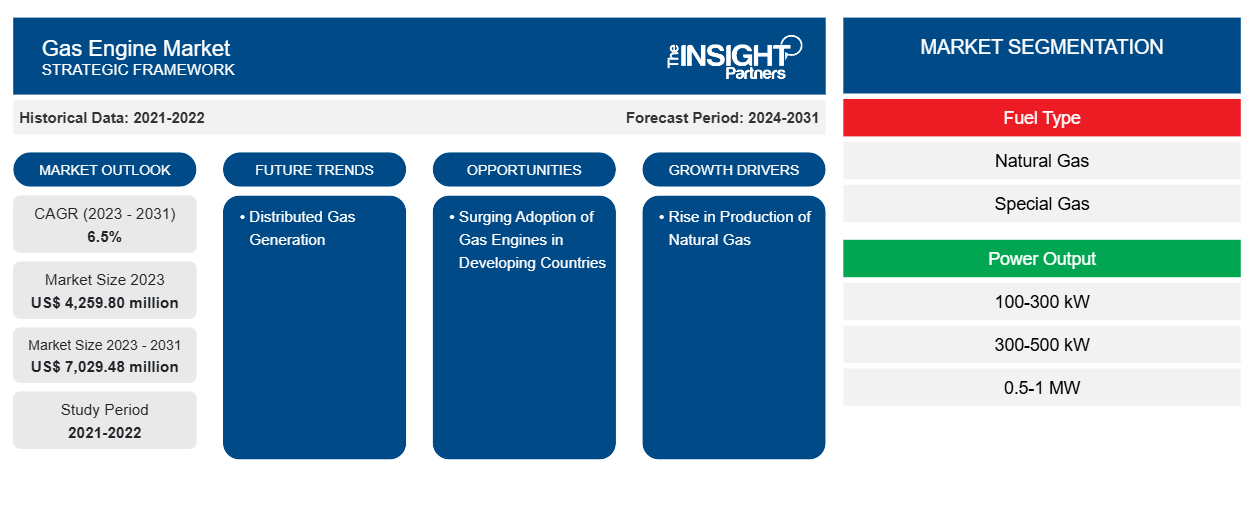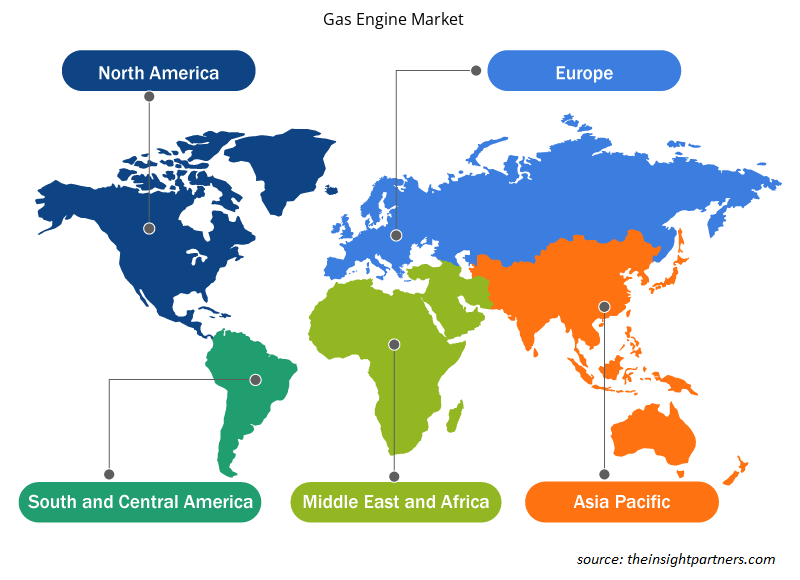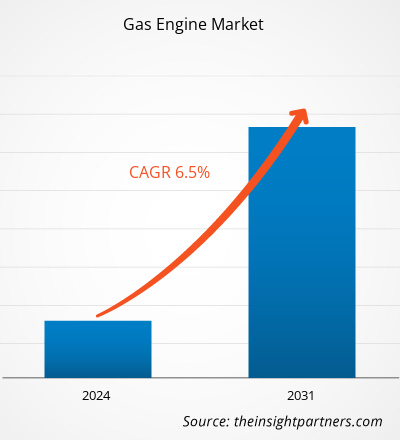Se espera que el tamaño del mercado de motores de gas alcance los 8.095,93 millones de dólares estadounidenses para 2031, frente a los 5.298,16 millones de dólares estadounidenses de 2024. Se estima que el mercado registrará una tasa de crecimiento anual compuesta (TCAC) del 6,4 % entre 2025 y 2031. Es probable que la creciente demanda mundial de energía impulse nuevas tendencias en el mercado en los próximos años.
Análisis del mercado de motores de gas
El creciente enfoque en el desarrollo de motores de combustible eficientes es uno de los factores clave que impulsan el crecimiento del mercado global de motores de gas . Además, se prevé que el aumento de la producción de gas natural y las actividades de exploración y producción a nivel mundial impulsen aún más la demanda de motores de gas durante el período analizado. Asimismo, se proyecta que los crecientes incentivos gubernamentales para la transición a energías limpias a nivel mundial generen oportunidades para los actores clave del mercado.
Descripción general del mercado de motores de gas
La industria de fabricación de motores de gas está evolucionando gracias a las innovaciones en la oferta de motores de gas natural para cumplir con los objetivos de emisiones. La creciente demanda de motores de bajas emisiones y bajo consumo de combustible para reducir la contaminación atmosférica y la llegada de motores de gas especiales a los sectores de fabricación, servicios públicos y generación remota impulsan el crecimiento del mercado de motores de gas. Asimismo, los motores alimentados con biogás, con mayor eficiencia eléctrica y bajas emisiones, están creando importantes oportunidades de crecimiento para los actores del mercado. Los fabricantes de motores de gas se centran en ofrecer productos avanzados para satisfacer la creciente demanda de alta potencia, cumpliendo con las normas de los motores diésel. Las principales industrias pesadas, centrales eléctricas remotas y empresas manufactureras están optando por motores de gas de alta potencia debido a su mayor eficiencia eléctrica y la reducción de los costes de combustible. El uso de gas natural en la tecnología de combustión de motores de gas puede resolver los problemas de emisiones, además de ayudar a los clientes a cumplir con las nuevas normativas. Se observa un aumento en la adopción de motores de gas en Sudamérica, África y Asia, mientras que América del Norte y Europa se centran en la adopción de energía solar y eólica durante el período de pronóstico. La creciente adopción de gas natural para la generación de energía en los sectores comercial, industrial y de la construcción está impulsando el crecimiento del mercado de motores de gas.
Personalice este informe según sus necesidades
Recibirá personalización de cualquier informe, sin cargo, incluidas partes de este informe o análisis a nivel de país, paquete de datos de Excel, así como también grandes ofertas y descuentos para empresas emergentes y universidades.
Mercado de motores de gas: Perspectivas estratégicas

-
Obtenga las principales tendencias clave del mercado de este informe.Esta muestra GRATUITA incluirá análisis de datos, desde tendencias del mercado hasta estimaciones y pronósticos.
Impulsores y oportunidades del mercado de motores de gas
Mayor atención al desarrollo de motores de combustible eficientes
Varios gobiernos están imponiendo regulaciones para controlar las emisiones de los motores diésel y de gasolina, lo que obliga a los fabricantes de motores a optar por combustibles alternativos como el gas natural. Los motores de gas emiten menos emisiones que otros tipos de motores para generar suficiente energía. Los organismos reguladores y de control de emisiones están imponiendo regulaciones estrictas sobre el uso de motores y generadores diésel. Diversas industrias están implementando motores y generadores de gas para la generación de energía con el fin de cumplir con estas normas regulatorias.
Cummins Inc. y Liberty Energy Inc. anunciaron el lanzamiento del primer motor de Inc. and Liberty Energy Inc. announced the launch of the industry’s first gas natural de velocidad variable y gran cilindrada de la industria para impulsar la plataforma de fracturación hidráulica digiPrime de Liberty, cuya implementación está prevista para el primer semestre de 2025. Esto se produce tras la alianza estratégica entre ambas compañías, establecida en junio de 2024, cuyo objetivo es desarrollar conjuntamente tecnología innovadora para el mercado de terminaciones y servicios. El motor de gas natural Cummins HSK78G, introducido inicialmente en marzo de 2019 como parte de un grupo electrógeno de velocidad fija para el sector de generación de energía, ha demostrado una fiabilidad excepcional al proporcionar energía constante en diversas fuentes de gas natural y entornos operativos. Los recientes avances en la plataforma digiPrime de Liberty utilizan el motor HSK78G y mejoran su tiempo de respuesta y la aceptación de carga. Esta colaboración supone un paso significativo en el crecimiento continuo del mercado de motores de gas, que continúa innovando en áreas de eficiencia y rendimiento operativo, especialmente en sectores como la fracturación hidráulica y la producción de energía. Así, el aumento en el desarrollo de motores de combustible eficientes, debido a las estrictas regulaciones relacionadas con los motores de gas, está impulsando el crecimiento del mercado.digiPrime hydraulic fracturing platform, set for deployment in the first half of 2025. This follows the strategic partnership between the two companies in June 2024, aimed at jointly developing innovative technology for the completions and services market. The Cummins HSK78G natural gas engine, initially introduced in March 2019 as part of a fixed-speed generator set for the power generation sector, has demonstrated exceptional reliability in providing consistent power across varying natural gas sources and operational environments. The recent advancements in Liberty’s digiPrime platform utilize the HSK78G engine and enhance its response time and load acceptance. This collaboration highlights a significant step in the ongoing growth of the gas engine market, which continues to innovate in areas of efficiency and operational performance, particularly within sectors such as hydraulic fracturing and energy production. Thus, the rise in the development of efficient fuel engines, owing to stringent regulations related to gas engines, is propelling the market growth.
Incentivos gubernamentales para la transición a la energía limpia
Los gobiernos apoyan cada vez más la transición hacia fuentes de energía más limpias como parte de sus objetivos más amplios de sostenibilidad ambiental. Esto es crucial para el impulso global hacia la descarbonización y la reducción de las emisiones de gases de efecto invernadero. Los gobiernos ofrecen diversos incentivos, subsidios y exenciones fiscales para fomentar la adopción de tecnologías más limpias y energéticamente eficientes. Los motores de gas, al ser una alternativa más limpia al carbón y al petróleo, están bien posicionados para beneficiarse de estas políticas de apoyo. Por ejemplo, el creciente énfasis en soluciones limpias y energéticamente eficientes en el transporte ha llevado al desarrollo de varios programas gubernamentales de subvenciones destinados a apoyar la transición de las flotas de transporte público a tecnologías sostenibles. La Administración Federal de Tránsito (FTA) ha desempeñado un papel importante a través de sus Subvenciones para Instalaciones de Autobuses y Bajas Emisiones. Estas subvenciones están diseñadas específicamente para ayudar a las agencias de transporte público en la transición de sus flotas a alternativas más limpias y energéticamente eficientes, como el gas natural renovable (GNR). Desde 2022, la FTA ha otorgado más de 500 millones de dólares estadounidenses para financiar diversos proyectos de gas natural, compensando significativamente las inversiones de capital de las agencias y facilitando la adopción de tecnologías de energía limpia. Estas subvenciones federales, particularmente en el sector del transporte, promueven el uso de autobuses y vehículos propulsados por gas natural, que se consideran cada vez más como una alternativa viable y respetuosa con el medio ambiente a las opciones impulsadas por diésel y gasolina.
Análisis de segmentación del informe de mercado de motores de gas
Los segmentos clave que contribuyeron a la derivación del análisis del mercado de motores de gas son el tipo de combustible, la potencia de salida, el usuario final y la aplicación.
- En cuanto al tipo de combustible, el mercado se clasifica en gas natural y gas especial. El segmento de gas natural dominó la cuota de mercado de motores de gas en 2024.
- Por tipo de potencia, el mercado se clasifica en 100-300 kW, 300-500 kW, 0,5-1 MW, 1-2 MW, 2-5 MW, 5-10 MW y 10-15 MW. El segmento de 5-10 MW dominó el mercado en 2024.
- Según el usuario final, el mercado se divide en generación de energía remota, midstream de petróleo y gas, industria pesada, manufactura ligera, servicios públicos, biogás, centros de datos, MUSH y comercial. El segmento de industria pesada dominó el mercado en 2024.
Análisis de la cuota de mercado de motores de gas por geografía
El mercado de motores de gas se segmenta en cinco regiones principales: América del Norte, Europa, Asia Pacífico (APAC), Oriente Medio y África (MEA) y América del Sur y Central (SAM). Europa dominó el mercado en 2024, seguida de Asia Pacífico y América del Norte.
El mercado de motores de gas en Europa está segmentado en Alemania, Francia, Reino Unido, Rusia e Italia. Europa ha sido líder en la adopción de soluciones de energía renovable, y la transición hacia fuentes de energía más limpias está impulsando significativamente el mercado de motores de gas. Países como Alemania, Italia y el Reino Unido están en transición hacia soluciones energéticas más sostenibles, integrando el gas natural y el hidrógeno como parte de sus estrategias de energía verde. El reciente lanzamiento por parte de MWM del motor de la serie TCG 3020, capaz de utilizar una mezcla de hidrógeno, refleja la apuesta del continente por el hidrógeno y el gas natural como futuras fuentes de energía. Además, el compromiso del Reino Unido con la neutralidad de carbono para 2050 y sus inversiones en tecnología de motores de gas demuestran la creciente demanda de tecnologías energéticamente eficientes y de bajas emisiones. Los ambiciosos objetivos de la Unión Europea de reducción de emisiones para 2030 impulsan aún más la demanda de motores de gas natural en la generación de energía, el transporte y las aplicaciones industriales.
Perspectivas regionales del mercado de motores de gas
Los analistas de Insight Partners han explicado detalladamente las tendencias y los factores regionales que influyen en el mercado de motores de gas durante el período de pronóstico. Esta sección también analiza los segmentos y la geografía del mercado de motores de gas en América del Norte, Europa, Asia Pacífico, Oriente Medio y África, y América del Sur y Central.

- Obtenga los datos regionales específicos para el mercado de motores de gas
Alcance del informe del mercado de motores de gas
| Atributo del informe | Detalles |
|---|---|
| Tamaño del mercado en 2024 | US$ 5.298,16 millones |
| Tamaño del mercado en 2031 | US$ 8.095,93 millones |
| CAGR global (2025-2031) | 6,4% |
| Datos históricos | 2021-2023 |
| Período de pronóstico | 2025-2031 |
| Segmentos cubiertos |
Por tipo de combustible
|
| Regiones y países cubiertos |
América del norte
|
| Líderes del mercado y perfiles de empresas clave |
|
Densidad de actores del mercado de motores de gas: comprensión de su impacto en la dinámica empresarial
El mercado de motores de gas está creciendo rápidamente, impulsado por la creciente demanda de los usuarios finales debido a factores como la evolución de las preferencias de los consumidores, los avances tecnológicos y una mayor conciencia de los beneficios del producto. A medida que aumenta la demanda, las empresas amplían su oferta, innovan para satisfacer las necesidades de los consumidores y aprovechan las tendencias emergentes, lo que impulsa aún más el crecimiento del mercado.
La densidad de actores del mercado se refiere a la distribución de empresas o compañías que operan en un mercado o sector en particular. Indica cuántos competidores (actores del mercado) hay en un mercado determinado en relación con su tamaño o valor total.
Las principales empresas que operan en el mercado de motores de gas son:
- INNIO
- Caterpillar Inc
- Cummins Inc
- Fairbanks Morse, LLC
- Industrias pesadas Kawasaki Ltd.
- Liebherr
Descargo de responsabilidad : Las empresas enumeradas anteriormente no están clasificadas en ningún orden particular.

- Obtenga una descripción general de los principales actores clave del mercado de motores de gas
Noticias y desarrollos recientes del mercado de motores de gas
El mercado de motores de gas se evalúa mediante la recopilación de datos cualitativos y cuantitativos tras la investigación primaria y secundaria, que incluye importantes publicaciones corporativas, datos de asociaciones y bases de datos. A continuación, se enumeran algunos de los desarrollos clave en el mercado de motores de gas:
- INNIO Group anuncia su nueva actualización del motor Waukesha VHP P9390X, diseñada para simplificar la operación y aumentar la confiabilidad. Esta actualización ofrece a los operadores la última tecnología en motores, prolongando la vida útil del equipo en un 60 %, a la vez que reduce el tiempo de inactividad y las emisiones en diversas condiciones de operación. (Fuente: INNIO Group, Comunicado de prensa, septiembre de 2024)
- Mitsubishi Heavy Industries Engine & Turbocharger, Ltd. (MHIET), parte del Grupo Mitsubishi Heavy Industries (MHI), lanzó el SGP M2000, un nuevo sistema de cogeneración con motor de gas natural con una potencia de 2000 kW. El nuevo sistema incorpora un motor de gas natural de 16 cilindros, modelo G16NB, que alcanza una eficiencia eléctrica del 44,3 %, la más alta del mundo para un motor de 2000 kW, y constituye un sistema de cogeneración compacto. (Fuente: Mitsubishi Heavy Industries, comunicado de prensa, marzo de 2023)
Informe de mercado de motores de gas: cobertura y resultados
El informe "Tamaño y pronóstico del mercado de motores de gas (2021-2031)" ofrece un análisis detallado del mercado que abarca las siguientes áreas:
- Tamaño y pronóstico del mercado de motores de gas a nivel global, regional y nacional para todos los segmentos clave del mercado cubiertos bajo el alcance
- Tendencias del mercado de motores de gas, así como dinámicas del mercado como impulsores, restricciones y oportunidades clave
- Análisis PEST y FODA detallado
- Análisis del mercado de motores de gas que cubre las tendencias clave del mercado, el marco global y regional, los principales actores, las regulaciones y los desarrollos recientes del mercado.
- Análisis del panorama industrial y de la competencia que abarca la concentración del mercado, el análisis de mapas de calor, los actores destacados y los desarrollos recientes del mercado de motores de gas.
- Perfiles detallados de empresas
- Análisis histórico (2 años), año base, pronóstico (7 años) con CAGR
- Análisis PEST y FODA
- Tamaño del mercado, valor/volumen: global, regional y nacional
- Industria y panorama competitivo
- Conjunto de datos de Excel
Informes recientes
Informes relacionados
Testimonios
Razón para comprar
- Toma de decisiones informada
- Comprensión de la dinámica del mercado
- Análisis competitivo
- Información sobre clientes
- Pronósticos del mercado
- Mitigación de riesgos
- Planificación estratégica
- Justificación de la inversión
- Identificación de mercados emergentes
- Mejora de las estrategias de marketing
- Impulso de la eficiencia operativa
- Alineación con las tendencias regulatorias






















 Obtenga una muestra gratuita para - Mercado de motores de gas
Obtenga una muestra gratuita para - Mercado de motores de gas